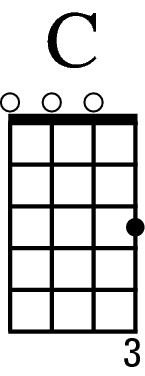Ukulele For Dummies (12 page)
Read Ukulele For Dummies Online
Authors: Alistair Wood

Chapter 4
Playing Your First Ukulele Chords and Songs
In This Chapter
 Meeting chord diagrams
Meeting chord diagrams
 Fretting your first chords
Fretting your first chords
 Starting with a simple strum
Starting with a simple strum
 Playing your first songs
Playing your first songs
C
hords are the perfect place to start learning to play music. With just two or three chords under your belt (or rather under your fingers) you can play along with songs, accompany your singing or play with other musicians.
Chords
are simply blocks of notes that are played together. They're the bedrock of music, the background of the song against which the melody is sung or played. Almost every song that you hear is based on a set of chords played in sequence.
In this chapter, I introduce you to seven chords (two of which are confusingly known as
seven chords
!). These few chords are going to take you a long way, however, allowing you to build up a large repertoire of tunes and forming the basis of your future ukulele playing.
Playing Music without Reading Music
I have to make a confession: I read music at about the same speed as a dog reads Latin. (I also spend a lot of time chasing squirrels and drooling on the carpet, but that's another story.)
Charting the history of chords
In the early days of music history, tunes were made up on single note lines. The earliest written music is the chanting of monks. Each monk would sing a tune that went its own merry way while the others sang their own lines. So each melody line was independent but fitted together harmoniously.
As time went on, composers started to think more about how these lines fitted together and started to focus on the sound of sets of notes played at the same time â chords.
Luckily, you don't need to read music â you can play chords just by looking at the pictures.
Reading chord diagrams
A
chord diagram
shows you exactly which finger you need to put where in order to play a certain chord.
A chord diagram represents the top five frets of the ukulele as you'd see them if you stood the ukulele up and looked straight at it, as in Figure 4-1.
Figure 4-1:
Top five frets on the ukulele neck.

Take a look at Figure 4-2 to see what a chord diagram looks like.
Figure 4-2:
A sample chord diagram.

Here are the parts of the chord diagram:
 Vertical lines
Vertical lines
represent the strings of the ukulele, starting with the g-string on the far left, moving to the A-string on the far right.
 The thick horizontal line
The thick horizontal line
at the top represents the nut of the ukulele.
 Thin horizontal lines
Thin horizontal lines
represent the frets. The first line below the nut is the first fret and the very bottom line is the fifth fret.
 The dots
The dots
show you exactly where to put your fingers. For example, if a dot is on the far left line between the first and second line, you need to hold down the g-string at the second fret.
The dots always appear on a vertical line and between the horizontal lines.
 The 0s at the top
The 0s at the top
are strings that are played open, which means you don't fret them at all.
